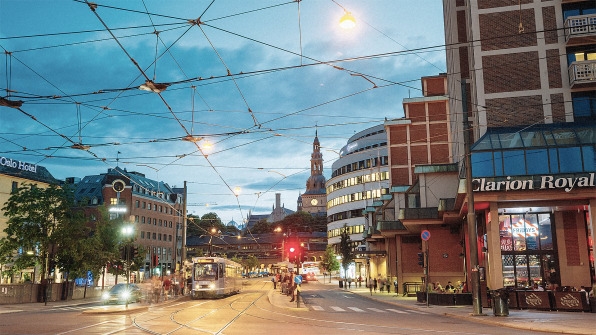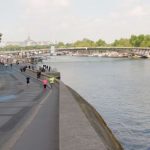If You Can’t Ban Cars Downtown, Just Take Away The Parking Spaces
All Oslo wanted to do was lighten its environmental footprint. But the Norwegian capital’s noble goal—to cut greenhouse gas emissions down to 95% of their 1990 levels by 2030—necessitated restricting car traffic. And that’s where the troubles began.
Transit accounts for 61% of Oslo’s carbon emissions; private cars are responsible for 39% of that total. So in 2015, the Oslo government decided to cut right to the heart of the issue and propose a car ban in the entire city center, which would’ve made Oslo the first European city to do so, leapfrogging ahead of others like Paris and Barcelona who have been toying with car restrictions for the past several years.
It seemed foolproof: In the heart of Oslo’s city center, 88.1% of people do not own a car; just 7% commute by private vehicle, with the majority preferring public transit, biking, or walking. But so vehement was the backlash from Oslo’s conservative faction, including of its automobile lobby, that the Oslo city council had to go back to the drawing board.

Instead of an outright car ban, Oslo has now announced a tactical-urbanism approach to limiting vehicle movement through the city center by simply removing all the parking spots from the area. There are currently 650; in their place, Oslo vice mayor for environment and transport Lan Marie Nguyen Berg told The Guardian, “we’ll put up installations and create public spaces. Some will be playgrounds or cultural events, or [contain] benches or bike parking—or other things you can fill the space with when you don’t have 1,200 kilograms of glass and steel.” Those plans are spelled out in more detail in the city’s outline for six pilot spaces, which include ideas for a beer garden and an “outdoor living area” featuring different pieces of street furniture and an e-bench with wifi and charging capabilities.
To ease the city center into this new iteration–to which there is still a substantial amount of objection, particularly from car owners and businesses–the car-limiting strategy will be rolled out in three phases: In stage one this year, all on-street parking in the central district will be removed, and the planned installations will go up; in 2018, the stage-two year, several streets will be closed to vehicle traffic and 40 miles of bike lanes will be built. During stage three in 2019, the city council will assess its progress, Berg told The Guardian: If the parking ban proves sufficient to set Oslo up to substantially slash carbon emissions, the city will extend the strategy; if it feels inadequate, the city council will resuscitate its initial plan to instigate an all-out car ban.
For those businesses owners concerned that the lack of parking in the central district will hamper their sales, a study of a Toronto neighborhood, previously covered by Fast Company, should give them some peace of mind. The study found that business owners drastically overestimated the percentage of their customers who arrived by car, and as such, voiced opposition to eliminating street parking in favor of more pedestrian routes and bike lanes. Visitors to the shops, on the other hand, far preferred the more humanized streets, and pedestrians and cyclists, as it turns out, were far more loyal customers, lingering longer in the shops, buying more, and exploring more outlets in the district instead of beelining back to their cars.
A handful of U.S. cities like Portland and Buffalo have eliminated or lowered parking minimums attached to new developments, recognizing that mandatory parking spots end up allocating more city space for vehicles than people, and make it impossible to reach the kind of carbon-reduction goals cities like Oslo are setting out. As planning professor Donald Shoup wrote in The High Cost of Free Parking, parking minimums “distort transportation choices toward cars, and thus increase traffic congestion, air pollution, and energy consumption…they damage the economy and degrade the environment. They debase architecture and urban design.”
Through converting its city center streets to more human-centered use, Oslo hopes to instill the logic of going car-free in its residents, rather than force them to do so by law (it will also have to figure out how to accommodate people who are unable to walk to the stores). But as Beathe Radby Schieldrop, communications manager for Oslo’s trade association, told The Guardian, the success of the whole plan will be contingent on getting business owners engaged, too. “Make every street a success, and then celebrate the transformation,” she said. “Success is totally dependent on the participation of shops and cafes—no one will sit on a bench in an empty street.”
Oslo had a plan to lower its emissions by drastically limit car travel in its center. Now you can drive, but it might not be worth it.
All Oslo wanted to do was lighten its environmental footprint. But the Norwegian capital’s noble goal—to cut greenhouse gas emissions down to 95% of their 1990 levels by 2030—necessitated restricting car traffic. And that’s where the troubles began.
(40)













